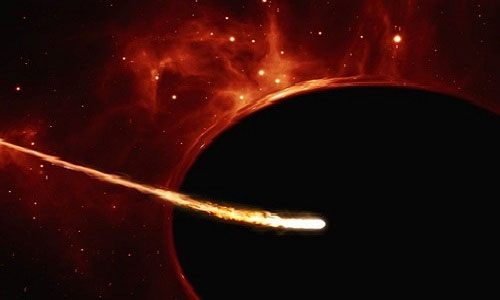The painful death of a star ripped apart by a supermassive black hole
The supernova is 20 times brighter than the brightness of the entire Milky Way, which is essentially the corpse of a star so close to the super black hole and torn apart.
The new observations of astronomers show that the event known as ASASSN – 15lh is not a supernova explosion but the painful death of a star too close to the supermassive black hole, according to Science Alert. . The results of the study were published Dec. 12 in Nature Astronomy.
In June last year, scientists encountered a blinding light in the universe, believed to be the strongest supernova explosion in history with a peak at 20 times the brightness of the entire Milky Way. .
Normally, a star that reaches a sufficiently large mass at the end of its life cycle will explode to become a supernova. The explosion occurred because the star burned off the fuel or contained too much material. Considered the largest explosion in space, the brightness of ASASSN – 15lh is twice as large as the previous record, drawing the attention of the astronomical community.

Black holes are swallowing a star.(Photo: ESO, ESA / Hubble, M. Kornmesser).
Stars can only reach the end of their life when nothing else happens in the process, according to the leading research group, Giorgos Leloudas, an astronomer at the Weizmann Institute of Science, Israel.
"We observed the source within 10 months after the event and concluded that it was not an extremely bright supernova," Leloudas said. "The results indicate that this event may be due to a supermassive black hole that rotates very fast and destroys a star with a smaller mass."
ASASSN – 15lh is located in a galaxy about 4 billion light-years from Earth. The hypothesis posed by the research team is that the supermassive black hole is located in the center of the distant star system and attracts stars near it.
When a star comes too close to the black hole, it will be torn apart in the "tidal interruption event" , where intense gravitational currents stretch the material into long thin filaments. This process is called spaghettification . In order to destroy such a star, the black hole ASASSN – 15lh must have at least 100 million times the mass of the Sun.
"The tidal disruption that we propose cannot explain to a non-rotating black hole , " said Nicholas Stone of Columbia University, a member of the research team. "We think that ASASSN – 15lh is the interruption of the tide formed by a very special black hole."

The fast-spinning material disk contains the remains of a Sun-like star torn apart by the gravitational pull of the black hole.(Photo: ESO, ESA / Hubble, M. Kornmesser).
Non-rotating black holes do not affect stars outside its event horizon, the boundary where gravity cannot escape the black hole. But a spinning black hole called a Kerr black hole has no such limit.
If the research hypothesis is correct, the high intensity light of ASASSN – 15lh is the result of the star being pulled towards the black hole. When this happens, the star's spiked material will collide with itself and produce high temperatures, forming a blazing light explosion that scientists initially thought was a supernova. special.
"Now that we have the right tools and know what we're looking for, we'll find more and get a better sense of their numbers. It's interesting because this is a new way to find out. understand the black hole and the death of stars , " Stone said.
- The supermassive black hole closest to Earth glows intensely
- Researchers are about to film a supermassive black hole
- Video: The moment the super black hole ripped and swallowed a star
- Satisfying the red star scene label N6946-BH1 entered the monster black hole
- The star flies more than 1,000 km / sec after 'hiding' from the black hole
- Super-large black hole rotates rapidly near the speed of light
- Video: Compare the size of black holes in the universe
- Detecting the supermassive black hole is spraying material
- The three galaxies unite to
- The supermassive black hole is about to swallow 3 clouds of Earth
- The moment the supermassive black hole swallowed
- Black holes were stripped when two galaxies collided
 Van Allen's belt and evidence that the Apollo 11 mission to the Moon was myth
Van Allen's belt and evidence that the Apollo 11 mission to the Moon was myth The levels of civilization in the universe (Kardashev scale)
The levels of civilization in the universe (Kardashev scale) Today Mars, the sun and the Earth are aligned
Today Mars, the sun and the Earth are aligned The Amazon owner announced a secret plan to build a space base for thousands of people
The Amazon owner announced a secret plan to build a space base for thousands of people